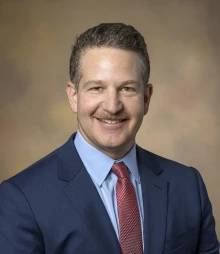Fostering Mental Health Support During a Pandemic
Protecting mental health is important for fighting stress and keeping healthy. Resources are available for support during the COVID-19 era.

Health care providers are at risk of burnout, especially during the current pandemic.
During the COVID-19 pandemic, it is more important than ever for people to have the information, support and connections they need to help navigate mental health challenges.
Jordan Karp, MD, is the University of Arizona College of Medicine – Tucson’s new chair of the Department of Psychiatry. He shares tips for how individuals can protect their own mental health, as well as pointers for health care providers looking out for their patients’ wellbeing.
What are some of the pandemic’s main impacts on mental health in the general population?

Jordan Karp, MD
While they may not be constant for everyone, I would say that in some ways, we have all experienced these challenges at times. We may define this condition as an increase in stress. The result of too much stress on mental health can result in either a worsening of pre-existing mental illness, or a development of a new mental illness.
The most commonly worsened or new-onset conditions include anxiety, depression, insomnia, thoughts of suicide and substance misuse.
Are there populations at heightened risk of mental health challenges during the pandemic?
I am particularly concerned about three patient populations who may experience negative health effects of the pandemic.

During the pandemic, many children and teens have lost out on social interaction and activities such as sports, which may affect their mental health.
Second, older adults may be especially isolated, given lower rates of “digital connection” for this group. Fear of infection may interfere with routine health care and increase loneliness, and those with cognitive decline may be at elevated risk of not having basic needs met.
Third are those with severe and persistent mental illness, such as schizophrenia. These patients may have a gap in care, are at increased risk of homelessness and poor self-care, and require special attention.
In what ways can health care providers help patients struggling with issues such as depression, anxiety and isolation?
Health care providers can normalize the experience by making it routine to ask all their patients about stress, anxiety, depression, insomnia, substance misuse and, if indicated, thoughts of suicide. The use of standard screeners that assess depression, anxiety and substance use, which patients can complete in advance of the appointment, can also normalize these emotions and behaviors, and make their assessment feel routine for patients, similar to having vital signs assessed. Health care providers also can create a nonthreatening emotional space for their patients by saying something like, “We are living in extraordinary and stressful times. Are you having problems with (and then list the symptoms to be screened)?”
What are some of the main impacts of the pandemic on health care providers’ mental health?

To fight against stigmas surrounding mental health, doctors and other health care providers can normalize mental health screening.
Efforts to prevent and treat mental illness and promote the physical and mental wellness of health care workers need to be a national priority. I encourage health care workers to speak with their supervisors and ask their human resources team about local resources available to them.
What are some of the ways society can prioritize mental health?
Ways to address the epidemic of mental illness include research, access and advocacy.
Research: It is imperative we learn about the most effective, patient-centered and resource-efficient ways to prevent and treat mental illness on a large scale. Supporting research into these conditions is especially important now during the pandemic.
Access: There is a shortage of mental health specialists to provide clinical care. Efforts to increase the numbers of psychiatrists, psychologists, social workers and others who work to improve mental health should be encouraged. Additionally, there are many evidence-based online programs and apps that address depression, anxiety, insomnia and stress.
Advocacy: If people agree that efforts to boost research and access to care is important, they can make sure they are registered to vote in the next election, and they also can contact their state and federal representatives.

